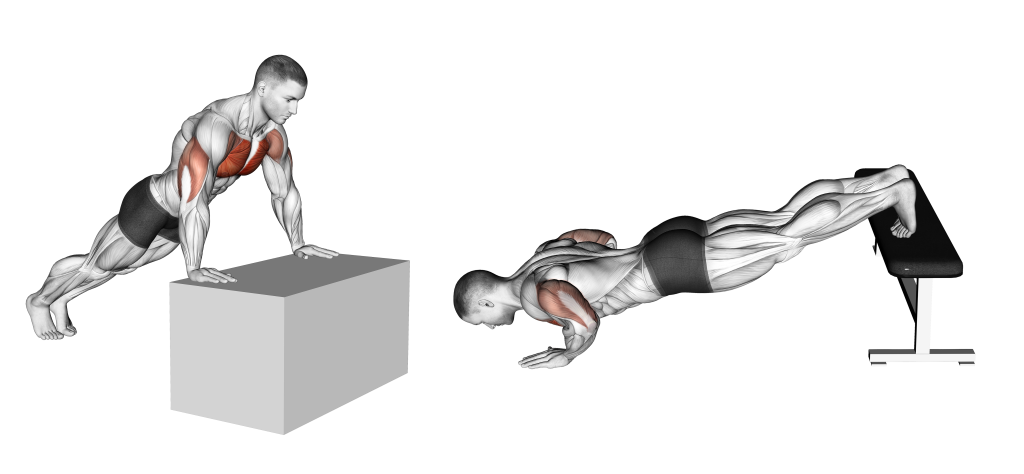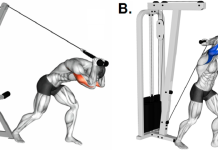Elevate your fitness routine with the decline push-up! Learn proper technique and sculpt your upper body. Get started today.
Decline Push Up – Elevate Your Fitness Routine
Are you looking to take your fitness to the next level? Meet the decline push-up, a powerful exercise that can sculpt your upper body and supercharge your results. In this comprehensive guide, we’ll explore the science-backed benefits of decline push-ups, master the proper technique for maximum effectiveness, and show you how to integrate this dynamic move into your workout routine. Let’s dive in!
Benefits of Decline Push Ups: Strengthen, Sculpt, Succeed
When it comes to upper body strength and muscle development, decline push-ups reign supreme. This variation takes the classic push-up to new heights, quite literally! Here’s why you should make decline push-ups a staple in your fitness repertoire:
1. Targeted Muscle Activation: Unlike traditional push-ups, decline push-ups elevate your feet, engaging your chest, shoulders, and triceps more intensely. This added challenge not only builds muscle but also enhances muscle definition, giving you that sculpted look you’ve been striving for.
2. Core Engage: One of the most exciting benefits of decline push-ups is the heightened engagement of your core muscles. Your abs and obliques work overtime to maintain stability, helping you develop a strong, solid core—a foundation for overall strength and balance.
3. Calorie-Torching Power: Looking to burn more calories during your workout? Decline push-ups require more effort and energy, resulting in increased calorie expenditure. Whether you’re aiming for weight loss or simply want an efficient workout, decline push-ups have your back.
4. Functional Strength: The strength gained from decline push-ups isn’t just for show—it translates to real-life activities. Whether you’re lifting heavy objects, playing sports, or simply performing everyday tasks, the upper body and core strength you gain from decline push-ups will come in handy.
5. Time Efficiency: Short on time? Decline push-ups offer a potent workout in a shorter duration. Get more bang for your buck by incorporating this exercise into your routine.

Proper Technique and Form: Mastering the Decline Push-Up
Achieving optimal results from decline push-ups requires mastering the right technique. Follow these steps to ensure you’re getting the most out of each rep:
1. Set Up Your Equipment: Find a stable surface for your feet, such as a bench, sturdy box, or step. Place your hands on the ground, slightly wider than shoulder-width apart, forming a strong foundation.
2. Maintain a Straight Line: Imagine your body as a plank. Keep your back, hips, and legs aligned in a straight line from head to heels. This alignment is crucial for engaging the correct muscles and avoiding strain.
3. Mind Your Elbows: As you lower your body, keep your elbows at a 45-degree angle from your torso. This angle optimizes muscle activation while reducing stress on your shoulders.
4. Full Range of Motion: Lower yourself with control until your chest is just above the ground. Aim for a deep range of motion while maintaining proper form. Push through your palms to return to the starting position.
5. Breathe and Focus: Remember to breathe throughout the movement. Inhale as you lower your body, and exhale as you push back up. Stay focused on maintaining a strong core and stable posture.
6. Gradual Progression: If you’re new to decline push-ups, start with a slight decline (e.g., using a low step). As you become more comfortable and stronger, gradually increase the decline for a greater challenge.
7. Listen to Your Body: Pay attention to how your body feels during the exercise. If you experience discomfort or strain, stop and reassess your form. Proper technique is key to avoiding injuries and obtaining optimal results.
Targeted Muscle Groups: Sculpting Your Upper Body
Decline push-ups are a powerhouse move that targets key muscle groups, helping you achieve a strong, chiseled upper body. Understanding which muscles are engaged can help you make the most of this exercise:
1. Chest (Pectoral Muscles): The primary muscle group worked during decline push-ups is the chest, specifically the pectoral muscles. The angle of the decline intensifies the activation of your chest muscles, making this exercise highly effective for building chest strength and definition.
2. Shoulders (Deltoids): Your shoulder muscles, known as deltoids, play a crucial role in stabilizing and controlling the movement during decline push-ups. This exercise helps sculpt rounded, well-defined shoulders.
3. Triceps: The triceps, located on the back of your upper arm, are heavily engaged as you push yourself up from the decline position. This results in toned and strong triceps.
4. Core (Abdominals and Obliques): As mentioned earlier, decline push-ups significantly engage your core muscles. Your abdominals and obliques work hard to keep your body in a straight line, contributing to core stability and overall strength.
5. Upper Back (Trapezius and Rhomboids): While the focus is on the front of the body, the upper back muscles also play a supportive role in maintaining proper form. This balanced engagement contributes to better posture and overall upper body development.
6. Serratus Anterior: The serratus anterior, a muscle that runs along the sides of your ribcage, is activated during decline push-ups. Strengthening this muscle enhances shoulder stability and adds to the overall aesthetic appeal of your upper body.
By targeting these muscle groups, decline push-ups provide a comprehensive upper body workout that can yield impressive results.
Decline Push-Up vs. Regular Push-Up: Choosing the Best Fit
While both decline push-ups and regular push-ups are effective exercises, they offer distinct benefits that cater to different fitness levels and goals:
1. Decline Push-Ups:
- Greater Muscle Activation: The decline angle engages muscles more intensely, making it an excellent choice for those seeking muscle growth and definition.
- Advanced Variation: Decline push-ups are a natural progression for individuals who have mastered regular push-ups and want to challenge themselves further.
- Core Emphasis: The added core engagement sets decline push-ups apart, making them a valuable addition to any core-focused routine.
2. Regular Push-Ups:
- Suitable for All Levels: Regular push-ups are a fundamental bodyweight exercise suitable for beginners and experienced fitness enthusiasts.
- Versatility: Regular push-ups can be modified to target specific muscle groups (e.g., wide grip for chest, close grip for triceps).
- Widespread Benefits: Regular push-ups are great for overall upper body strength, endurance, and maintenance.
Deciding between the two depends on your fitness level, goals, and available equipment. Incorporating both variations can provide a well-rounded upper-body workout.
Integrating Decline Push-Ups into Your Routine: The Key to Progress
Now that you’re familiar with the benefits of decline push-ups and their target muscle groups, it’s time to discuss how to incorporate them into your fitness routine for maximum progress.
1. Frequency and Sets: For optimal results, aim to include decline push-ups in your routine 2-3 times per week. Start with 2-3 sets of 8-12 repetitions. Gradually increase the number of sets and reps as you become more comfortable and stronger.
2. Warm-Up: Before diving into decline push-ups, it’s essential to warm up your muscles. Spend 5-10 minutes performing dynamic stretches and light cardio to increase blood flow and prepare your body for the workout.
3. Superset with Complementary Exercises: Pairing decline push-ups with other upper body exercises can create an effective superset. For example, alternate between decline push-ups and exercises like incline dumbbell presses or seated dips. This approach targets various angles and muscle groups, leading to comprehensive upper body development.
4. Progression Strategies: To continually challenge yourself, consider implementing the following progression strategies:
- Increasing Decline Angle: Gradually elevate your feet to increase the decline angle. This added challenge intensifies muscle activation.
- Adding Resistance: If you’re comfortable with bodyweight decline push-ups, you can add resistance by wearing a weight vest or placing a weight plate on your back.
- Plyometric Variations: Incorporate explosive push-ups (plyometric push-ups) to improve power and explosiveness. However, ensure you have a solid foundation in regular decline push-ups before attempting plyometric variations.
5. Listen to Your Body: As with any exercise, it’s crucial to listen to your body. If you experience pain or discomfort, scale back or modify the exercise. Proper form is paramount for avoiding injuries and making progress.
6. Rest and Recovery: Allow your muscles time to recover between workout sessions. Muscles grow during rest, so ensure you’re getting adequate sleep and providing your body with proper nutrition.
Safety Precautions: Before starting any new exercise program, it’s advisable to consult with a healthcare professional, especially if you have any existing medical conditions or injuries. Proper form and safety should always be a top priority.
By integrating decline push-ups into your routine and following these guidelines, you’ll unlock the full potential of this exercise and experience significant progress in your upper body strength, muscle development, and overall fitness journey.
Common Questions and Myths: Demystifying Decline Push-Ups
As with any popular exercise, decline push-ups come with their fair share of questions and misconceptions. Let’s address some common inquiries and dispel any myths to ensure you have a clear understanding of this powerful workout:
1. Are decline push-ups suitable for beginners?
While decline push-ups provide an excellent challenge, they may not be the best starting point for beginners. It’s essential to build a solid foundation with regular push-ups and other basic exercises before progressing to declines. Once you’ve developed sufficient upper body strength and core stability, you can gradually introduce decline push-ups to your routine.
2. Do I need specialized equipment for decline push-ups?
You can perform decline push-ups using common items like a sturdy bench, step, or low platform. These items provide the necessary elevation for your feet. If you’re at a gym, there might be dedicated decline benches or equipment, but they’re not essential to get started.
3. Can decline push-ups replace regular push-ups entirely?
While decline push-ups offer unique benefits, they shouldn’t entirely replace regular push-ups in your workout routine. Regular push-ups provide versatility, engage different muscle groups, and are suitable for all fitness levels. It’s best to include both variations in your routine to achieve a balanced upper body workout.
4. Will decline push-ups make my chest “sink” or look unnatural?
This is a common misconception. When performed correctly and in moderation, decline push-ups can enhance chest muscle definition, giving a natural and sculpted appearance. However, like any exercise, overdoing it can lead to an imbalanced physique. Proper form and a balanced approach are crucial.
5. Can decline push-ups lead to shoulder injuries?
When performed with proper form and a controlled range of motion, decline push-ups are generally safe. However, if you have pre-existing shoulder issues, it’s essential to consult a healthcare professional before attempting decline push-ups. Start with a moderate decline angle and focus on maintaining shoulder stability.
6. Will decline push-ups help me lose weight faster?
Decline push-ups, like any exercise, contribute to calorie burning and muscle development. However, weight loss primarily depends on a combination of factors, including diet, overall activity level, and consistency in your fitness routine. Decline push-ups can be a valuable addition to a comprehensive weight loss plan but should be combined with a balanced diet and regular cardiovascular exercise.
By addressing these questions and myths, we aim to provide clarity and ensure that you can approach decline push-ups with confidence and knowledge. Now that you’re well-informed, it’s time to take action and experience the benefits firsthand.
Real-Life Success Stories: Inspiration and Motivation
Before you embark on your decline push-up journey, let’s draw inspiration from individuals who have incorporated this exercise into their routines and achieved remarkable results. These success stories highlight the transformative power of decline push-ups and showcase the positive impact they can have on your fitness goals.
(In this section, you can include one or more real-life success stories or testimonials from individuals who have seen significant improvements in their upper body strength, muscle development, or overall fitness by incorporating decline push-ups into their routines.)
Elevate Your Fitness with Decline Push-Ups
Congratulations! You’ve gained valuable insights into the world of decline push-ups, from understanding the targeted muscle groups to mastering proper form and integration into your fitness routine. Remember that consistency, proper technique, and gradual progression are keys to success.
As you embark on your decline push-up journey, stay committed, listen to your body, and enjoy the transformative journey towards a stronger, more sculpted upper body. Whether you’re aiming to build muscle, enhance core stability, or simply challenge yourself, decline push-ups are a fantastic addition to your fitness toolkit.
Thank you for joining us on this exploration of decline push-ups. Here’s to your continued success and a stronger, healthier you!
Resources and References: (In this section, you can provide links or references to reputable sources, video tutorials, or articles for further reading and to support the information presented in the article.)
Disclaimer: Always consult a healthcare professional before beginning any new exercise program, especially if you have pre-existing medical conditions or injuries.
Frequently Asked Questions (FAQs) – Decline Push-Ups
Q: Can I do decline push-ups if I’m a beginner?
A: While decline push-ups are more challenging, it’s best to start with regular push-ups to build a foundation.
Q: How often should I do decline push-ups?
A: Aim for 2-3 times per week, allowing your muscles time to recover between sessions.
Q: What’s the ideal decline angle for beginners?
A: Start with a slight decline (e.g., a low step or incline board) and gradually increase as you progress.
Q: Do decline push-ups work the same muscles as regular push-ups?
A: Decline push-ups emphasize the upper chest, shoulders, and core, while regular push-ups target a broader range of upper body muscles.
Q: Are decline push-ups suitable for women?
A: Absolutely! Decline push-ups can benefit both men and women, helping to tone and strengthen the upper body.
Q: Can I do decline push-ups without any equipment?
A: Yes, you can use a sturdy surface like a bench or low platform as the decline surface.
Q: Will decline push-ups make my arms bulkier?
A: While they can help build muscle, it’s unlikely to cause significant bulk unless combined with a specific muscle-building program.
Q: How many decline push-ups should I do per set?
A: Start with 8-12 reps per set and adjust based on your fitness level.
Q: Can I do decline push-ups if I have wrist pain?
A: If you experience wrist discomfort, consider using push-up handles or focusing on other chest exercises that don’t strain the wrists.
Q: Are decline push-ups more effective than regular push-ups?
A: Both variations offer unique benefits. It’s beneficial to include both in your routine for a well-rounded upper body workout.
Q: Should I do decline push-ups before or after regular push-ups?
A: Order doesn’t matter; you can do them in the same workout or on different days, depending on your preferences.
Q: How do I prevent lower back pain during decline push-ups?
A: Maintain a straight line from head to heels, engaging your core to support your lower back.
Q: Can decline push-ups help with reducing belly fat?
A: While they burn calories and engage core muscles, spot reduction (losing fat from a specific area) isn’t possible; overall fat loss requires a combination of exercise and a healthy diet.
Q: Can I do decline push-ups if I’m pregnant?
A: It’s essential to consult with a healthcare professional during pregnancy. Decline push-ups might not be suitable, and modified exercises may be recommended.
Q: How long does it take to see results from decline push-ups?
A: Individual results vary, but with consistency and proper technique, you may start noticing improvements in strength and muscle definition in a few weeks.
Q: Should I do decline push-ups on an empty stomach?
A: It’s generally best to have a small meal or snack before exercising to ensure you have enough energy.
Q: Can I combine decline push-ups with other exercises in a single workout?
A: Absolutely! Combining decline push-ups with complementary exercises can create a challenging and efficient workout.
Q: Are decline push-ups suitable for older adults?
A: It depends on individual fitness levels and any pre-existing conditions. Consult with a healthcare professional before attempting decline push-ups, especially for older adults.
Q: How long should I rest between sets of decline push-ups?
A: Aim for 1-2 minutes of rest between sets to allow your muscles to recover.
Q: Can decline push-ups help with improving posture?
A: While decline push-ups primarily target the upper body, a strong core and back can contribute to better overall posture.




